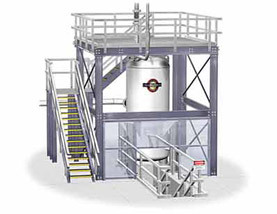
The lab's 900 MHz NMR magnet is a superconducting magnet.
A superconducting magnet is just like a regular electromagnet, except that there is no resistance to electricity. If it's a resistive coil, you're losing power, and it's generating heat. There's no heat generation here, so you're not losing energy. For that, you can generally go to higher currents, which means you can have a more compact magnet. But also there's a low operating cost, due to the fact that you're not losing electrical energy as you power it. With traditional, resistive magnets, you have megawatts of power that you'll dump for the equivalent magnetic field. So superconducting magnets, to keep them superconducting, you have to have low temperatures, generally 4.2 Kelvin, approximately -452 degrees Fahrenheit. To do that, you have to have it in liquid helium, or some kind of cryo-cooler is required. The cost for helium is quite high, but still, costs are less than what it takes to power a resistive magnet.
Meet the MagLab's 32 tesla all-superconducting magnet, the strongest superconducting magnet in the world.


